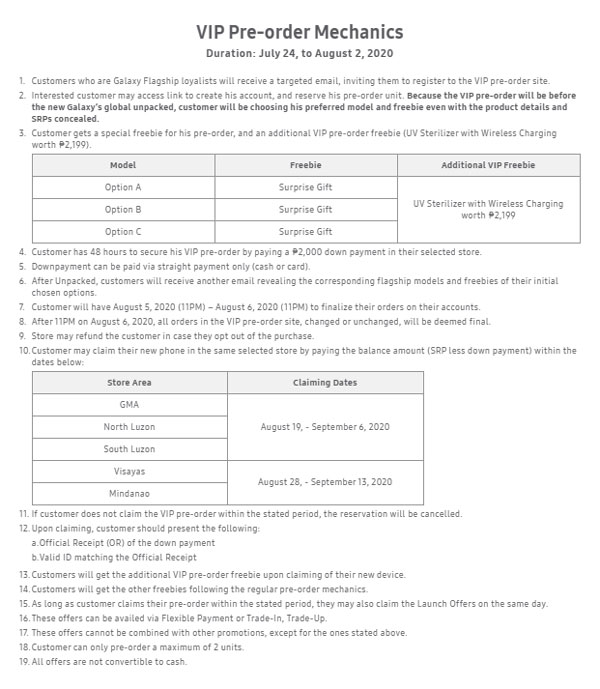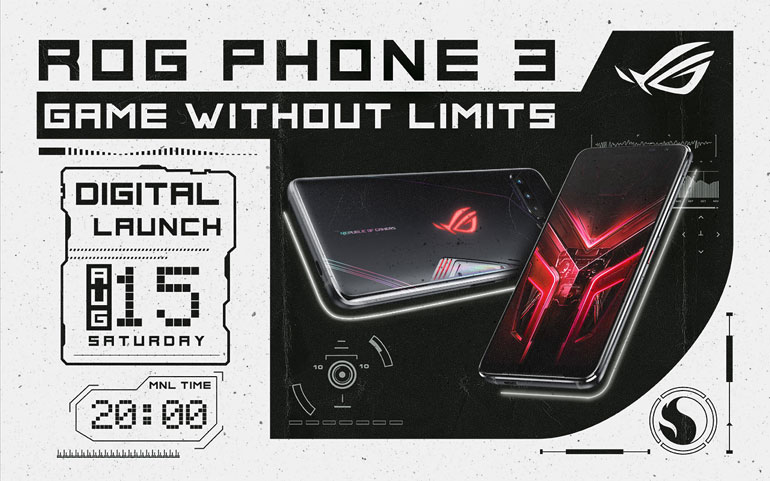ASUS ROG Phone 3 vs Lenovo Legion Phone Duel - Specs Comparison - Android
There are two types of high-end phones. There’s your regular flagship that offers the top specs in the market, then there’s the gaming phones that goes way over the top. We’ve seen a couple of them in the last two years and now, more of them has arrived. In today’s specs comparison, we’ll be looking […] More
This article, ASUS ROG Phone 3 vs Lenovo Legion Phone Duel: Specs Comparison, was originally published at NoypiGeeks | Philippines Technology News, Reviews and How to's.
There are two types of high-end phones. There’s your regular flagship that offers the top specs in the market, then there’s the gaming phones that goes way over the top.
We’ve seen a couple of them in the last two years and now, more of them has arrived. In today’s specs comparison, we’ll be looking at some of the latest ones, starting with the ASUS ROG Phone 3.

The third installment from ASUS’ popular line aims to keep the reputation that was set by the first model. Other than having the best of the best processor, this gaming phone pretty much maxes out all the other hardware to give a ludicrous amount of power.
Three years since its initial release, the ROG Phone is facing a new competition with the Lenovo Legion Phone Duel, the company’s first entry in this category.

So the question is, how was Lenovo’s first attempt compare with the third sequel of the ROG Phone? We find out in our ASUS ROG Phone 3 versus Lenovo Legion Phone Duel specifications and features comparison.
| ASUS ROG Phone 3 | Lenovo Legion Phone Duel | |
| Operating System | Android 10 ROG UI | Android 10 ZUI 12 Legion OS |
| SIM | Dual SIM Dual Standby | Dual SIM Dual Standby |
| Display | 6.59-inch FHD+ AMOLED 2340 x 1080 pixel resolution 391ppi 144Hz refresh rate 270Hz touch sampling 10-bit HDR10+ DCI-P3 NTSC sRGB TÜV Low Blue Light certification Flicker Reduced certification Corning Gorilla Glass 6 | 6.59-inch FHD+ AMOLED 2340 x 1080 pixel resolution ~388ppi HDR10+ 144Hz refresh rate 240Hz touch sampling |
| Processor | 3.1GHz Qualcomm Snapdragon 865 Plus octa-core Qualcomm Snapdragon 865 octa-core processor (Strix Edition) | 3.1GHz Qualcomm Snapdragon 865 Plus octa-core |
| RAM | 12GB/16GB RAM 8GB RAM (Strix Edition) | 8GB/12GB |
| GPU | Adreno 650 | Adreno 650 |
| Storage | 256GB/512GB UFS 3.1 non-expandable | 256GB/512GB UFS 3.1 non-expandable |
| Front Camera | 24-megapixel | 20-megapixel Side pop-up |
| Rear Camera | 64-megapixel (f/1.8, Quad Bayer, PDAF) 13-megapixel (ultra-wide, 125-degree) 5-megapixel (macro) 8K@30fps 720p@480fps slow-mo EIS | 64-megapixel (f/1.8) 16-megapixel (ultra-wide, f/2.2) PDAF LED flash 4K@30fps EIS |
| Audio | Stereo speakers Hi-Res audio Quad microphones No headphone jack | DIRAC stereo speakers AWINIC 88264 Quad microphones No headphone jack |
| Security | In-display fingerprint scanner Face unlock | In-display fingerprint scanner Face unlock |
| Connectivity | HSPA+, 4G LTE 5G WiFi 6 Bluetooth 5.1 NFC Dual-band GPS, GGNSS, GLONASS, Galileo, BDS, QZSS, NavIC USB Type-C Side-mounted accessory port | HSPA+, 4G LTE 5G WiFi 6 Bluetooth 5.1 NFC Dual-band GPS, GGNSS, GLONASS, Galileo, BDS, QZSS USB Type-C Side-mounted accessory port |
| Others | AirTriggers 3 ROG accessories compatible AeroActive Cool 3 included | Ultrasonic triggers Side pop-up camera |
| Dimensions | 171 x 78 x 9.85mm | 169.17 x 78.48 x 9.90mm |
| Weight | 240g | 239g |
| Body | Front: Gorilla Glass 6 Back: Gorilla Glass 3 | Front: Glass Back: Glass Water-repellent coating |
| Colors | Black Glare | Vengeance Red Blazing Blue |
| Battery | 6,000mAh 30W fast charging | 5,000mAh 90W Fast Charge |
| Price | 12GB/512GB: EUR999 (~Php57,100) 16GB/512GB: EUR1,099 (~Php62,800) 8GB/256GB (Strix Edition): EUR799 (~Php45,700) | 8GB/128GB: CNY3,499 (~Php 24,700) 12GB/128GB: CNY 3,899 (~Php27,500) 16GB/512GB: CNY5,999 (~Php43,000) |
Design and Build Quality
It wouldn’t be a gaming phone with the aggressive gaming design, and both phones doesn’t disappoint — especially the Lenovo Legion Duel.

As you can see, it has a really distinct design on the back. Lenovo even put the dual cameras in the middle to accommodate for this unique look, with Legion’s signature Y logo in the middle with configurable RGB lighting.
Lenovo also put the pop-up camera on the side so you can stream your gameplay online. Although, we know that some people are skeptical about pop-up mechanism and the possible durability issues.
 ASUS ROG Phone 2 | ASUS ROG Phone 3
ASUS ROG Phone 2 | ASUS ROG Phone 3On the other hand, ASUS have slightly toned-down the design on the ROG Phone 3. It still has the RGB-lit logo on the back, but the edgy design accents have been minimized.
Since they are bombarded with features, both the ASUS ROG Phone 3 and Lenovo Legion Duel are bulkier than most flagships. Both handsets almost have the same 9.9mm thickness and weight of 239g, while normal flagships only averages at around 8mm and 180g, respectively.
Display and Audio
Spoiler alert: the ASUS ROG Phone 3 costs more than the Legion Phone Duel. Which is why the former has a couple more features than the latter, and you can notice that in the display department.

Both phones have identical 6.59-inch FHD+ AMOLED screens, with HDR10+ support, and a smooth 144Hz refresh rate — perfect for gaming phones.
However, ASUS’s bet do have a 270Hz sampling rate, while the latter has 240Hz. This basically means that the ROG Phone 3 is more responsive to touch, making the screen all the more faster and smoother.

The ROG Phone 3’s webpage also reveals that the device has DCI-P3, NTSC, and sRGB coverage for better colors. It also has reduced blue light and flicker certifications for your eyes’ safety. On the other hand, no mentions of these features in Lenovo’s website.
Both devices also has stereo speakers and quad microphones for better calls and recording. The ROG Phone 3 has Hi-Res audio, while the latter has a dedicated amplifier. However, they both lack a headphone jack. But they do come with a Type-C to 3.5mm port adapter in the box.
Hardware and Performance
It’s not a real gaming phone if you don’t have the ‘Plus’ version of Qualcomm’s flagship processor. Both the ASUS ROG Phone 3 and Lenovo Legion Phone Duel comes with the latest Qualcomm Snapdragon 865 Plus processor, an overclocked version of the Snapdragon 865 found on regular flagships.
 ASUS ROG Phone 3
ASUS ROG Phone 3This processor also allowed both snartphones to have the next-gen connectivity features such as 5G, WiFi 6, and Bluetooth 5.1. They also have their respective cooling solutions, although the one on the ROG Phone looks more intricate.
But since it’s the more premium option, you can rig the ROG Phone 3 with 16GB of RAM. On the upside, it have a Strix Edition that has 8GB of RAM and runs on a non-Plus Snapdragon 865 processor.
 Lenovo Legion Phone Duel
Lenovo Legion Phone DuelBoth devices also comes with 256GB/512GB of fast UFS 3.1 storage. As per ASUS, there are no 1TB UFS 3.1 chip available yet, so instead of coming up with a slower storage option, they just capped it with 512GB. This is also probably the reason why the two handsets lack storage expandability.
Battery
The ASUS ROG Phone 3 boasts a 6,000mAh battery, while the latter only has 5,000mAh. It may look like it would last for two to three days, but considering their demanding processor and high refresh-rate screens, you might have to reach for the charger every night.

Speaking of charging, here’s where the Lenovo Legion Duel steals the show. It comes with a whopping 90W fast charger, while the former only has 30W. Lenovo had to split the battery in to two 2,500mAh to achieve this feat. Not as impressive as OPPO’s 125W charger, but it should still be enough to provide a 0% to 100% charge in under an hour.
Related
- Realme X3 SuperZoom vs POCO F2 Pro: Specs Comparison
- Xiaomi Mi 10 vs Black Shark 3: Specs Comparison
Cameras
Gaming phones are not known for their camera prowess, and these two are no exemption. Both of them come with 64-megapixel main cameras, with the Lenovo device having a sharper 16-megapixel ultra-wide, while the ASUS one has dedicated macro camera and can record 8K videos.

The ROG Phone 3 has a sharper 24-megapixel selfie camera. Although the side-mounted pop-up camera on the Legion Duel sure is a conversation starter, and actually useful if you want to stream directly out of it.
Their cameras may not be Huawei P40 Pro-level quality — they don’t even have OIS — but they do the job.
Others
Gaming phones are known for being extra. Other than the ludicrous design and performance, both devices also have shoulder triggers — ASUS gave it an AirTriggers 3 moniker, while Lenovo simply calls them ultrasonic triggers. They can recognize taps and slides to enable different commands on games.

But if you’re really heavy in gaming, ASUS has created a couple of gaming accessories for the ROG Phone. There’s a special dock so you can game on your TV and a gameboy-like case that adds an extra screen.
ASUS kept the dimensions of the ROG Phone 3 the same to its predecessor to keep the accessories compatible.

There’s also the AeroActive Cooler 3, which is basically a cooling fan you can attach on the back to keep it cool when gaming. The best part is, it has RGB, a kickstand, and comes free on the package.
Conclusion
Obviously, the ASUS ROG Phone 3 takes the win on this comparison. It has a faster and more feature-packed screen, better cameras, bigger battery, and support for accessories with one of them included in the box.
24/07/2020 04:46 PM
Realme C11 vs Redmi 9A - Specs Comparison
24/07/2020 11:36 AM
First impressions - realme C11
24/07/2020 06:51 AM
Samsung Galaxy Note 20 pre-order page is now up in the Philippines
24/07/2020 11:16 AM
Dry clean at home with the Samsung AirDresser
24/07/2020 07:32 AM
Do you still remember these PC Ports
24/07/2020 04:49 PM
Pinoy gamer defeats two-time DOTA 2 world champion n0tail in 1v1 showmatch
24/07/2020 01:42 AM
ASUS ROG Phone 3 will launch in the Philippines on August 15
24/07/2020 05:31 AM
- HEALTH
- Comics
- Libraries & Demo
- Sports Games
- Racing
- Photography
- Transportation
- Media & Video
- Sports
- Health & Fitness
- Weather
- Medical
- Cards & Casino
- Arcade & Action
- Personalization
- Social
- Communication
- Productivity
- Casual
- Shopping
- Tools
- Brain & Puzzle
- Business
- News & Magazines
- Finance
- Lifestyle
- Music & Audio
- Entertainment
- Travel & Local
- Books & Reference
- Education
2014 © Filipino apps and news







